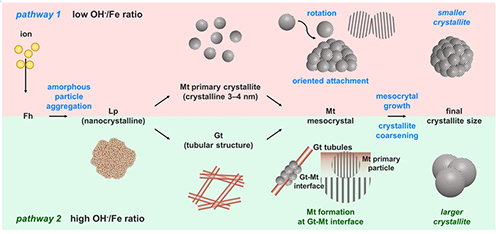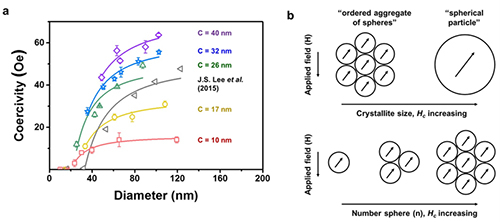Professor Young-Keun Kim’s Team reveals the process of forming nanosized iron oxide mesocrystals
The results were published in prominent international journal Nature Communications.

▲ Professor Young-Keun Kim (corresponding author, Korea University), Doctor Bum-Chul Park (first author, Research Institute
of Engineering and Technology, Korea University), and Ji-ung Cho (first author, Korea Basic Science Institute).
Professor Young-Keun Kim’s team in the Department of Materials Science and Engineering, College of Engineering, conducted a joint study with Doctor Bum-Chul Park’s team from the Korea Basic Science Institute, and revealed the change of the microstructure of nanosized magnetite iron oxide mesocrystals in the crystallization process, proposing a new approach to phase transformations.
*Mesocrystal: An assembly of smaller crystallites. Mesocrystals are drawing attention from the industry because they exhibit collective properties that are dissimilar from those of single-crystallite particles.
The joint research team found that the size of the crystallites constituting mesocrystals is dependent upon the various pathways through which magnetite (Fe3O4) iron oxide mesocrystals are formed, and successfully controlled the magnetic properties of the iron oxide mesocrystals by controlling the size of the crystallites as well as their assemblies. The results were published on January 15 in Nature Communications, a globally prominent journal.
*Title of Article: Strategy to control magnetic coercivity by elucidating crystallization pathway-dependent microstructural evolution of magnetite mesocrystals
*Authors: Professor Young-Keun Kim (corresponding author, Korea University), Doctor Bum-Chul Park (first author, the Research Institute of Engineering and Technology, Korea University), and Ji-ung Cho (first author, Korea Basic Science Institute).
Due to the unique size-dependent magnetic properties, magnetite iron oxide is a promising material in medical applications, including body imaging, in vitro diagnosis, and hyperthermia, and in electronic applications, including magnetic shielding and stealth technology. For the application of magnetite iron oxide to such a wide range of areas, magnetic coercivity, one of the indexes of magnetic properties, should be precisely controlled according to the applications. In addition, the microstructure and its size are critical factors to the magnetic coercivity. However, chemical synthesis has significant limitations in the precise design of the microstructure, because the process of forming the microstructure from chemically synthesized nanoparticles is highly complicated.
*Magnetic coercivity: An index representing the reverse magnetic field required to reduce the magnetization of a magnetic material to 0 (zero). Magnetic coercivity is significantly dependent upon the composition, size and microstructure of the material.
The research team investigated the time-dependent change in the process of forming magnetite iron oxide mesocrystals, and found that different sizes of crystallites constituted the mesocrystals in the process of forming the mesocrystals from different intermediate polymorphs. Based on this principle, the research team succeeded in the independent control of the diameter of the magnetite iron oxide mesocrystals and the size of the crystallites, and proposed an experimental model that shows the effect of the crystallite size on the magnetic coercivity depending on the diameter of the mesocrystals.
*Polymorphs: Substances having an identical composition but different properties because of the differences in the atomic bonding.
*Intermediate: An instable material before becoming the most thermodynamically stable form. Some crystals are not formed immediately from the ions in a solution but after going through several intermediates.
The present study, supported by the Nano and Materials Source Technology Development Program of the Ministry of Science and ICT, and the Advanced Research Project of the National Research Foundation of Korea (NRF) and the Ministry of Science and ICT, revealed the hidden principles of microstructure formation in the composite metal oxide materials. The principles are expected to be applied to a wide range of metal oxides that are formed through stepwise phase transformations. The results of the present study have an academic significance because the new approach may be employed for the precise control of microstructures. Moreover, the experimental model proposed in this study about the diameter-magnetic coercivity behavior of the magnetite iron oxide mesocrystals depending on the crystallite size has an industrial significance because the proposed model is a platform applicable to various medical and electronic fields where the precise control of the magnetic coercivity is required.

(Figure 1) Schematic illustration of the two newly identified crystallization pathways of iron oxide mesocrystals. Pathway 1, often found when an excessive quantity of iron precursor is injected in comparison with the hydroxide ion (OH-), includes ferrihydrite (Fe5HO8·4H2O), lepidocrocite (γ-FeOOH) and magnetite (Fe3O4) in order. Pathway 2, found when the quantity of the injected iron precursor is less than in Pathway 1, includes ferrihydrite (Fe5HO8·4H2O), lepidocrocite (γ-FeOOH), goethite (α-FeOOH) and magnetite (Fe3O4) in order. The magnetite iron oxide mesocrystals formed through Pathway 1 comprise smaller crystallites than those formed through Pathway 2.

(Figure 2) Magnetic coercivity model according to the diameter of the magnetite iron oxide mesocrystals and the size of the crystallites. The magnetic coercivity measured from five groups having different average crystallite sizes is shown as a function of the mesocrystal diameter (solid line in Figure 2a). The model well fits with the known experimental formula. The crystallites constituting mesocrystals are arranged in the same crystallographic direction. Therefore, they can be described as ordered aggregate of spheres. As shown in the plot in Figure 1a, the ordered aggregate of spheres has a magnetic coercivity smaller than the crystallite particles of the same volume. This means that crystallites are easily magnetized by an external magnetic field because they have magnetic interactions with each other. Also found was that the magnetic coercivity was increased as the number of the crystallites constituting a mesocrystal was increased. This is well matched with the known experimental formula representing the dependence of the magnetic coercivity upon the particle diameter. The meaning of this find is that when the crystallites have magnetic interactions with each other, the mesocrystals tend to behave like a single particle.



